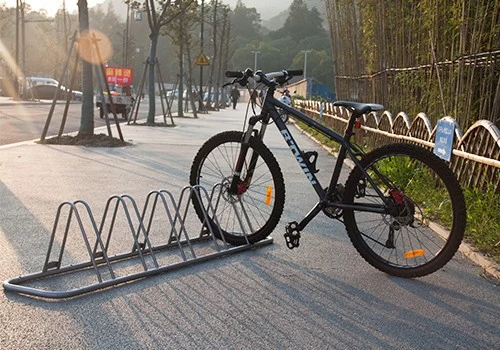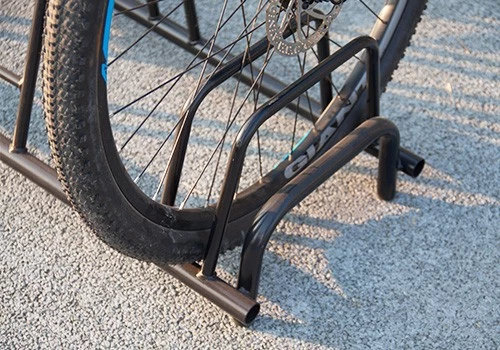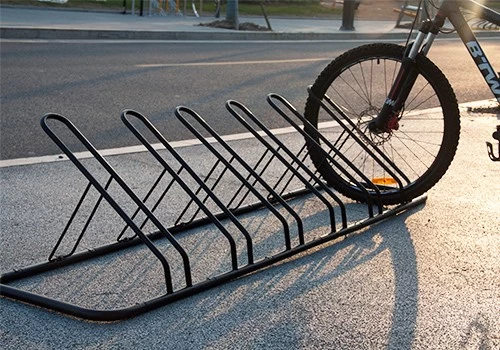Specifications
Model Number : PV-SC-001
Type: Bike parking and storage
Color:Yellow,Black,Green,Red,or Customized.
Style : both indoors and outside
Material : carbon steel
Loading: According to customer need
Size :195*23.2*75cm,200.55*23.2*75cm,or Customized.
Finish: hot-galvanized
Specifications
Model Number : PV-0081-01
Type: Bike parking and storage
Color:silver
Style : both indoors and outside
Material : carbon steel
Loading: According to customer need
Size :Height 1463mm, Depth 1114mm
Finish: hot-galvanized
Model Number : PV-0081-01
Type: Bike parking and storage
Color:Black
Style : both indoors and outside
Material : carbon steel
Loading: 2-10 bikes (According to customer need)
Size :Height 1463mm, Depth 1114mm
Finish: hot-galvanized
Model No.: PV-H1
Size: w605*D400*H330mm
Specification: Round tube:¢16*1.2mm
Finish: Power coated
Net Weight: 1.6 kgs
Packing size:6pcs/ctn
MOQ: 100pcs
Model Number : PV-0024-01
Material : carbon steel/stainless steel
Loading: according customer space size,we can design according the size
Size : W1977*D1130(depend on your parking space)*H2500mm
Finish: Powder coated ,hot-galvanized/electric polish
Packing size :2000*2000*2500mm(40 parking space )
Powder coated ,hot-galvanized/electric polish
Product number:PV-0046-01
Material:carbon steel
Specification:10.2*59*28CM or Customized.
MOQ:100PCS
Port:Shanghai
Trademark:PV
Model Number : PV-0081-01
Type: Outdoor Bike Parking Rack
Style : both indoors and outside
Material : carbon steel
Loading: 2-10 bikes (According to customer need)
Size :170.5*116*148CM
Finish: hot-galvanized
Model Number : PV-0055-01
Type: compact flat pack /slot
Color:black / silver /yellow/optional
Style :Outdoor/indoor
Material : carbon steel/ stainless steel
Capacity : park 6 bikes
Size : L1400*W1054*H840mm
Net weight :38KG
Finish: powder coating / hot galvanized /elctropolishing
Packing size :1490*860*160mm 1pcs/ctn
Product Name: Multi-Capacity Horizontal Two Tier Bike Parking Rack
Material: Carbon Steel
Finish: Powder coated
Post: 80mm * 80mm thickness: 3mm
Steel plate: thickness: 2mm
Dimension: 1325*1890*1830mm
Weight: 370 kg/set
Model: PV-0067-01
Material: stainless steel 304
Pipe: 50 mm* 2.5 mm
Size: 900*700 mm(L*W)
Surface treatment: polishing

In cities around the world, a quiet revolution is unfolding. Bike lanes are multiplying, shared e-bike services are expanding, and commuters are increasingly trading car keys for handlebars. The global bicycle market has seen a 23% growth in active users since 2020, with urban cycling rates rising by nearly 40% in major metropolitan areas. Yet amid this cycling renaissance, a critical challenge persists: poor bicycle parking infrastructure. Cities invest millions in bike lanes and bike-sharing programs, only to see their efforts undermined by inadequate, poorly designed parking solutions that leave cyclists frustrated, bikes vulnerable to theft, and sidewalks cluttered with haphazardly locked bicycles.
As a leading manufacturer of bicycle parking solutions, we’ve come to understand a fundamental truth: a bicycle rack is more than just a piece of metal—it’s a critical interface between cyclists and the urban environment. The difference between a rack that gets used properly and one that collects dust lies not in durability alone, but in how well it understands the psychology of the people who use it. This blog explores the science behind user-centric bicycle rack design, revealing how thoughtful engineering can encourage proper use, enhance urban aesthetics, and ultimately make cycling a more appealing choice for everyone.
Before diving into design principles, let’s quantify the problem of inadequate bicycle parking. A 2024 study by the Urban Cycling Institute found that 68% of cyclists have abandoned a planned trip because of poor parking options, while 43% reported avoiding certain destinations entirely due to parking concerns. Worse, 31% of bicycle thefts in urban areas are directly attributed to insufficient or poorly designed parking infrastructure—costing cities millions in insurance claims, police resources, and lost cycling participation.For businesses, the impact is tangible. Retail districts with subpar bicycle parking see 22% fewer cycling customers than those with quality facilities, according to research from the Transportation Research Board. Property managers report that buildings with inadequate bike storage lose out on rental premiums, as 76% of urban renters now consider secure bicycle parking a “must-have” amenity.
The psychological toll is equally significant. Cyclists describe the daily hunt for parking as a “stressful ritual” involving risk assessment (Will my bike be safe?), physical effort (Can I lift my bike onto that rack?), and social calculus (Will I block pedestrians if I lock here?). These micro-stresses create a invisible barrier to cycling, discouraging even committed riders from making the switch from cars.

To design effective bicycle racks, we must first understand the mental processes that guide cyclists’ parking decisions. Behavioral psychologists identify several key factors that influence whether a cyclist will use a rack properly—or abandon it entirely for a lamppost or signpost.
The Principle of Least Effort
Humans are hardwired to conserve energy, a tendency psychologists call the “principle of least effort.” This explains why cyclists often choose the closest, most accessible parking option—even if it’s not designated for bikes. A study in Portland, Oregon, found that cyclists will walk an average of only 40 feet from their destination to a bike rack before considering alternatives. Beyond that distance, compliance drops by 57%.This principle has profound implications for rack placement. Racks hidden around corners, tucked behind buildings, or placed more than a short walk from entrances will inevitably be underused. User-centric design acknowledges this by prioritizing visibility and proximity, ensuring racks are positioned where cyclists naturally look for them.
Perceived Security Matters More Than Actual Security
While actual security features like tamper-resistant bolts and robust materials are essential, research shows that perceived security drives parking decisions. Cyclists assess a rack’s safety based on visible cues: Is it located in a well-lit area? Can it be seen from passing pedestrians or building windows? Does it allow for locking both the frame and wheels?A 2023 survey by Cycling UK found that 82% of cyclists prioritize parking spots with “good visibility” over those with high-security locks but poor sightlines. This explains why racks placed in dark alleyways or isolated corners—even if technically secure—are often avoided in favor of more visible (but less secure) alternatives like street signs.
The “Norm of Appropriateness”
Social psychology teaches us that people tend to follow behaviors they perceive as socially acceptable or “appropriate” for a given situation. This “norm of appropriateness” means cyclists are more likely to use a rack if it clearly signals, “This is where bikes belong.”
Conversely, ambiguous or poorly designed racks create confusion. A common example is the traditional “wave” rack with narrow spacing between bars, which often leads cyclists to lock their bikes around the rack instead of to it because the intended use isn’t intuitive. Clear, intuitive design eliminates this ambiguity, making proper use the default behavior.
Emotional Connection to Personal Property
For many cyclists, their bike is more than a tool—it’s a valued possession with emotional significance. This emotional connection intensifies the need for parking solutions that feel “caring” rather than punitive. Racks that seem flimsy, unstable, or likely to scratch bike frames trigger anxiety, leading cyclists to seek alternatives that feel gentler on their property.
This explains the growing popularity of racks with rounded edges, protective coatings, and ample spacing—features that signal respect for the cyclist’s investment. User-centric design recognizes that parking isn’t just about securing a bike; it’s about respecting the person who owns it.
Core Principles of User-Centric Bicycle Rack Design
Armed with this psychological insight, user-centric bicycle rack design incorporates five core principles that encourage proper use while enhancing the overall cycling experience.
Visibility: Make Racks Impossible to Miss
A rack can’t be used if it can’t be seen. User-centric designs prioritize visibility through strategic placement and thoughtful aesthetics. This means positioning racks near building entrances, along main pedestrian paths, and in well-lit areas. High-visibility colors or distinctive shapes can further enhance noticeability, though designers must balance visibility with urban aesthetics to avoid creating eyesores.
Accessibility: Remove Physical Barriers
Bicycles come in all shapes and sizes—from road bikes and mountain bikes to cargo bikes and e-bikes. A user-centric rack must accommodate this diversity without requiring excessive physical effort. This means avoiding racks that force cyclists to lift heavy bikes, contort into awkward positions, or struggle with complicated locking mechanisms.
Features like low profiles for easy access, ample spacing between bars (at least 18 inches to accommodate wide tires and fenders), and multiple locking points address this need. For cargo bikes and e-bikes, which are heavier and bulkier, specialized racks with lower crossbars and reinforced supports reduce the physical strain of parking.
Security That’s Both Real and Perceivable
Effective racks combine robust security features with design elements that signal safety to cyclists. This dual approach includes:
These features work together to create a sense of security that reassures cyclists their bikes will be safe, encouraging them to use the rack instead of seeking riskier alternatives.
Intuitiveness: Design for “No Instructions Needed”
The best bicycle racks require no learning curve. A user-centric design is immediately understandable, with a form that clearly communicates its purpose. This means avoiding overly complex shapes or non-standard configurations that confuse cyclists.
Research shows that racks with simple, familiar geometries—like the classic “U-rack” or modern wave designs with generous spacing—have the highest compliance rates. These designs eliminate guesswork, ensuring cyclists can park quickly and confidently without struggling to figure out how the rack works.
Aesthetics: Racks as Urban Furniture
Bicycle racks are not just functional—they’re part of the urban landscape. A rack that complements its surroundings enhances the visual appeal of streets and public spaces, while an ugly, utilitarian rack can detract from the environment. This matters because cyclists (and communities) are more likely to value and use racks that contribute positively to the aesthetics of their neighborhood.
User-centric design embraces this by offering customizable options—from powder-coated colors that match local architecture to modular designs that can be arranged in patterns—that transform racks from eyesores into elements of urban art.

Our product lineup incorporates the lessons of user-centric design:
We recognize that different environments have unique needs. Our product line includes solutions for:
Beyond Racks: Comprehensive Parking Strategies
We don’t stop at manufacturing. Our team of mobility consultants works with clients to develop comprehensive parking strategies, analyzing traffic patterns, identifying optimal rack placement, and designing layouts that maximize capacity while ensuring ease of use. We provide data-driven recommendations that balance user needs with budget constraints and urban planning requirements.
As cities continue to embrace cycling as a cornerstone of sustainable mobility, the role of bicycle parking will only grow in importance. Emerging technologies are opening new possibilities for user-centric design, from digital capacity indicators that guide cyclists to available spots, to app-connected security systems that send real-time alerts about suspicious activity.But even as technology evolves, the core principle remains: successful bicycle parking solutions must put users at the center. By understanding the psychology of parking behavior, prioritizing convenience, visibility, and security, and designing with empathy for cyclists’ needs, we can create parking infrastructure that doesn’t just accommodate bikes—but actively encourages more people to ride them.
For cities, businesses, and institutions looking to support cycling, the message is clear: investing in user-centric bicycle racks isn’t just about providing a place to lock a bike. It’s about removing barriers to sustainable transportation, enhancing urban livability, and sending a clear message that cyclists are valued members of the community.At Suzhou Pioneer Vehicle, we’re proud to be part of this movement—building racks that don’t just hold bikes, but transform how people move through cities. Contact us today to learn how our user-centric designs can help your community embrace the future of urban mobility.